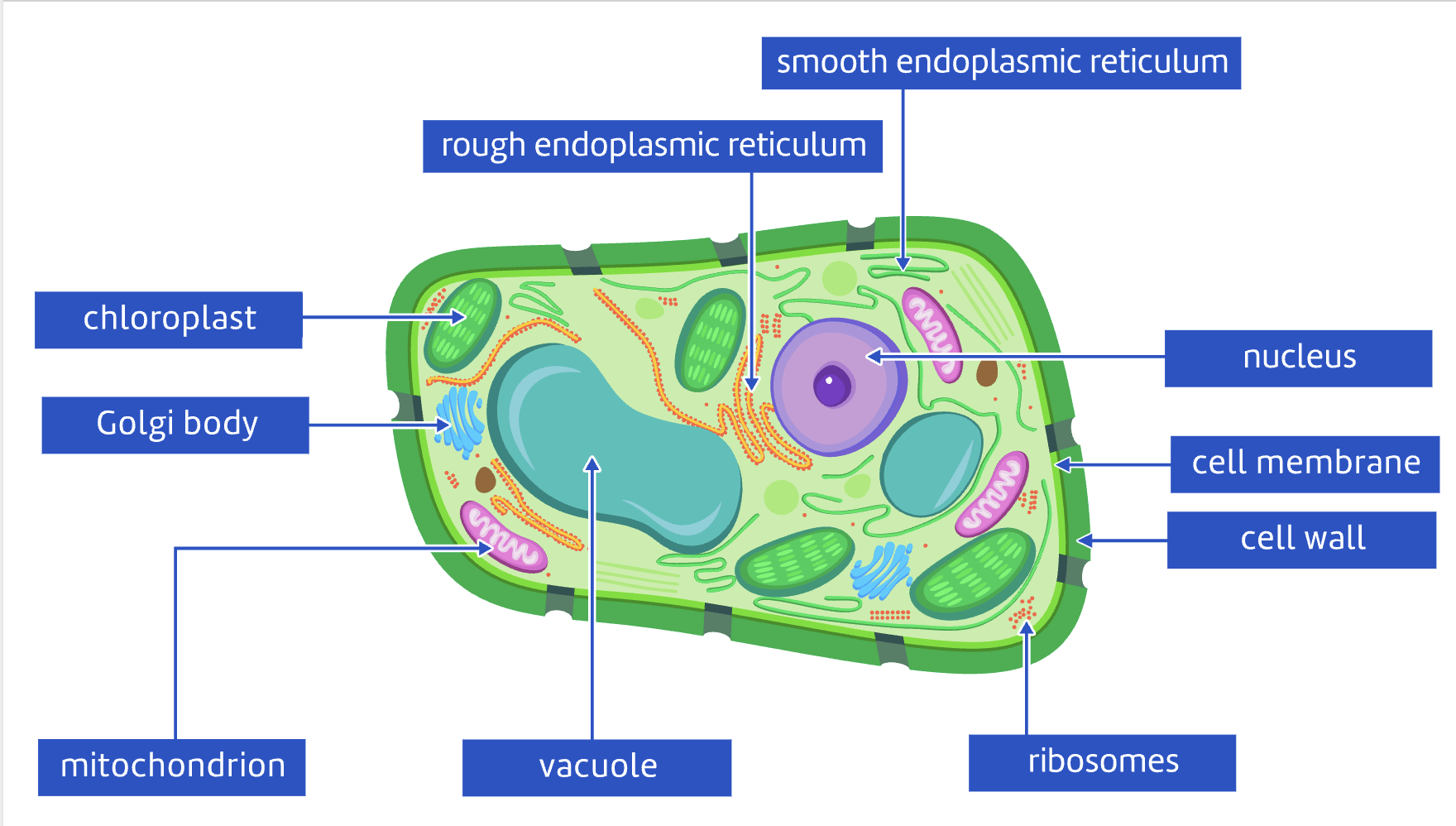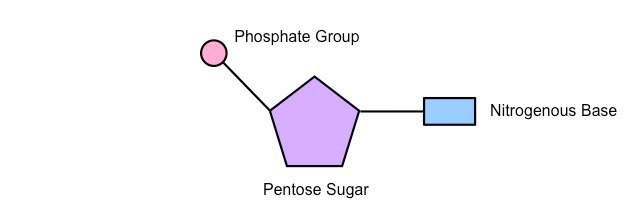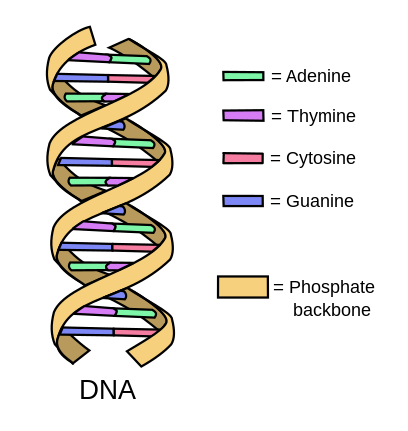Year 9 Science - DNA
1/28
There's no tags or description
Looks like no tags are added yet.
Name | Mastery | Learn | Test | Matching | Spaced |
|---|
No study sessions yet.
29 Terms
Plant cell organelles
Cell walls, chloroplasts and central vacuoles

Animal cell organelles
Ribosomes, mitochondria, cytoplasm, cell membrane, vacuole, nucleus
Function of DNA
The function of DNA is to store and transmit genetic information that guides the growth, development, functioning, and reproduction of all living organisms.
Why is DNA universal?
DNA is universal because it is the fundamental genetic material for all known living organisms, using the same nucleotide structures across diverse species.
Stucture of a nucleotide

DNA double helix

What are the four nitrogenous bases?
The four nitrogenous bases are adenine (A), thymine (T), cytosine (C), and guanine (G). A and T pair while C and G pair
Explain the relationship between genes, chromosomes and DNA
Genes are segments of DNA that carry the instructions for making proteins and determine specific traits. Chromosomes are long strands of DNA that contain many genes; they organize and package the DNA in a compact form within the nucleus of a cell. Therefore, DNA is the molecule that contains genetic information, genes are specific sequences within that DNA, and chromosomes are structures composed of tightly coiled DNA containing numerous genes
Define autosomes
Autosomes are the chromosomes that are not involved in determining the sex of an organism. In humans, there are 22 pairs of autosomes (making 44 individual autosomes) which carry the majority of an individual's genetic information.
Define sex chromosomes
Sex chromosomes are the chromosomes that determine the sex of an organism. In humans, there are two sex chromosomes: X and Y. Females typically have two X chromosomes (XX), while males have one X and one Y chromosome (XY).
Number of chromosomes present in normal human cells
Normal human cells typically contain 46 chromosomes, arranged in 23 pairs, which include 22 pairs of autosomes and 1 pair of sex chromosomes.
Scientists involved in the discovery of DNA structure
James Watson and Francis Crick are credited with discovering the structure of DNA, aided by the critical x-ray diffraction images produced by Rosalind Franklin and the research of Maurice Wilkins.
What are haploid chromosomes?
Haploid chromosomes refer to cells that contain a single set of chromosomes, which is half the number typical in diploid cells. In humans, haploid cells are represented by gametes (sperms and eggs), which contain 23 chromosomes.
What are diploid chromosomes?
Diploid chromosomes refer to cells that contain two complete sets of chromosomes, one inherited from each parent. In humans, diploid cells have 46 chromosomes, organized into 23 pairs.
Explain the difference between haploid and diploid chromosomes.
The primary difference between haploid and diploid chromosomes is the number of sets: haploid (n) cells have one set of chromosomes (23 in humans), while diploid (2n) cells have two sets (46 in humans). This distinction is important in sexual reproduction, where haploid gametes combine to form a diploid zygote.
What is a karyotype and how is it used?
A karyotype is a visual representation of an individual's complete set of chromosomes, organized by size and shape. It is used in genetics to identify chromosomal abnormalities, such as extra or missing chromosomes, and to study genetic disorders.
What are homologous chromosomes? What do the pair share?
Homologous chromosomes are pairs of chromosomes that have the same structure and gene sequences but may have different alleles. Each pair consists of one chromosome from each parent, and they share the same genes at the same loci, but the alleles for those genes may be different.
Distinguish between a male and female karyotype
A male karyotype typically has one X and one Y chromosome (XY), while a female karyotype has two X chromosomes (XX).
Down syndrome karyotype abnormality
Down syndrome is caused by an extra copy of chromosome 21, resulting in a condition known as trisomy 21. Individuals with Down syndrome typically have a total of 47 chromosomes instead of the usual 46.
Klinefelter’s syndrome karyotype abnormality
Klinefelter's syndrome is a genetic condition resulting from the presence of an extra X chromosome in males, typically characterized by a karyotype of 47,XXY. This condition can lead to physical and developmental characteristics such as reduced muscle mass, diminished testosterone levels, and potential fertility issues.
Examples of inherited traits
Examples of inherited traits include physical characteristics such as eye color, hair color, height, and certain genetic disorders like cystic fibrosis or sickle cell anemia.
Difference between dominant and recessive traits
Dominant traits are those that are expressed in the phenotype even when only one copy of the allele is present, while recessive traits are expressed in the phenotype only when two copies of the allele are present.
Genotypes for recessive traits
Recessive traits are expressed in the phenotype only when an individual has two copies of the recessive allele (genotype: aa).
What factors can influence the phenotype?
Phenotype can be influenced by genetic factors (the genotype), environmental factors (such as nutrition, temperature, and exposure to toxins), and interactions between genes and the environment.
Homozygous vs heterozygous
Homozygous refers to an organism that has two identical alleles for a particular gene, which can be either dominant (AA) or recessive (aa).
Heterozygous refers to an organism that has two different alleles for a particular gene, one dominant and one recessive (Aa).
phenotype vs genotype
Phenotype is the physical trait and genotype is a term that refers to the two alleles present.
allele
An allele is a variant or form of a gene that can exist at a specific position (locus) on a chromosome. Different alleles can result in different traits, such as eye color or blood type.
carrier
In genetics, a carrier is an individual who has one copy of a recessive allele for a particular genetic trait or disorder but does not show the associated symptoms or traits. This typically happens with recessive conditions, where two copies of the allele (one from each parent) are needed for the condition to be expressed. A carrier can pass the allele to their offspring, who might inherit two copies and develop the condition.
trait
In genetics, a trait is a characteristic or feature of an organism that is determined by its genes. Traits can be physical (like eye color, height, or flower color) or behavioral (like mating behavior or feeding habits). Traits are passed down from parents to offspring through genes, which come in different versions called alleles. Some traits are influenced by a single gene, while others are influenced by multiple genes and environmental factors.